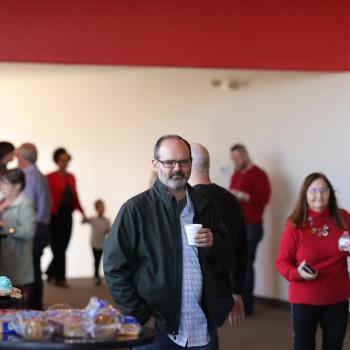Who are the leaders at the time of Christ? Is there a group who are considered part of a 3rd space at the time, if we think in something like concentric circles?
All three circles expand from an inner group sometimes called the Temple Cult.
- Priests, Levites, Synagogue Leaders/Priests, etc.
- Recognized leaders
- Pharisees, Scribes, Lawyers, etc.
To use the term Temple Cult may seem offensive
Cult in no way implies occult in historical Theology. This is a way of narrowing in on the socio-religious activities of a subgroup.
In this case the Temple Cult is known by tracking what historical documents we can through the way the Roman Empire interacts with their conquered nations, and the way the leaders of Israel interact with the empire. For instance, the Romans usually allow their conquered nations freedom of religion, as long as some type of allegiance to Caesar is maintained as well.
However, one must follow the money so to speak during the time of Christ. This is one of the ways to make sense of the courtroom proceedings leading to His crucifixion.
The Temple tax is indeed a powerful tax. It is so powerful in fact, that Rome decides to place their governor for the region directly in Jerusalem when there are other cities to choose from. Pilate, as well as others before and after him, oversee this region of the Roman Empire directly from Jerusalem.
The crucifixion is not only about the death penalty being approved by Pilate. There are good relations to be maintained.
The Temple attracts visitors from all over the known world, especially the Roman Empire, at least during all of the seven annual feasts. A tax is a quid pro quo.
1) Priests & Levites
The concentric circles start with something like royalty, leaders who have a birthright to lead in the religious, ethical, and societal realms of Israel.
2) Recognized leaders
The second group encompasses the type of leaders who have always had a voice, recognized leaders.
In the time of Christ some of them are Rabbis, teachers, and the Essenes.
There are also local experts. A Hebrew teacher reports that there’s a saying in some areas of Israel at that time, “If you can’t find the Rabbi, go to the carpenter.”
Beyond the Essenes, there are other groups of Aesthetics.
Then there are those who study the prophecies (Eschatological groups expecting the Messiah soon).
I know I am missing some. However, you can piece this second group of recognized leaders together from the latter part of the Hebrew Bible, the Intertestamental Period, the Gospel, and Acts.
3) Pharisees at the time of Christ are an enigma
My library is not available. I have other ways to research. However, it is futile because I will get the same answer. There is no record of the Pharisees in the Hebrew Bible. The Scribes and Lawyers seem to be new to the scene in the time of Christ as well.
In effect, they are the 3rd space in this writing, when thinking of concentric circles rippling outward from the Temple Cult.
This may come as a surprise because there is so much interaction with these groups in the Gospel and in Acts. However, there is no record I can think of that truly validates the origins of any of these groups. Scribes and Lawyers are not serving in the same capacity in the Hebrew Bible as these religious experts are in the Gospel, who are often found alongside the Pharisees.
It is possible they start to bloom in the Babylonian and Assyrian captivities, when the people of God are spread far apart from each other across the empires, and far away from Jerusalem. Certainly a local teacher, if not a royal priest per se, would be needed to teach Torah.
I do emphasize Torah because this seems to be their specialty. If indeed push comes to shove, which I think happens far less than we think it does, these groups tend to fall back on their expertise in the Law of Moses.
In defense of the Pharisees
The Pharisees, Sadducees, Scribes, and Lawyers seem to be doing something no one else can in Israel. They are teaching the Word among the people. In many ways, they are teaching like Christ is teaching at the time.
 The ways around and to the clock tower near the center of my son’s campus – many amazing conversations and events happen here over the course of time. I’ve had a few decent conversations in this area as well, or within sight of it. Ways and means of conversing like this with someone or others is outside the confines of a class, yet just as powerful for those who are charting a course.
The ways around and to the clock tower near the center of my son’s campus – many amazing conversations and events happen here over the course of time. I’ve had a few decent conversations in this area as well, or within sight of it. Ways and means of conversing like this with someone or others is outside the confines of a class, yet just as powerful for those who are charting a course.
I really don’t know if there is a shortage of formal Priests and Levites at the time. I don’t know the requirements for all of the synagogues. If Priests are appointed to synagogues, then there could be a shortage.
Everywhere the Jews go throughout the Roman Empire, they become well-respected for their business acumen and work ethic. They often find a seat at the table in the center of town, and that is where their synagogues are found geographically. If a priest is required/preferred at a synagogue, then I imagine Jerusalem can’t raise up priests quick enough to fill the vacancies all over the empire.
This leaves much of the local teaching to these newcomers, the Pharisees. They certainly have the ability to walk right in and talk to the religious elite. Pharisees also deliver messages from Jerusalem. They have some sort of religious rights.
Does Jesus really spend His time at odds with them?
Are we reading more into the Text than is written?
Are we reading our tone, our angry tone into the Text?
Is it a hot debate between Jesus and the Pharisees for 3 solid years, or is it more like banter?
There are certainly times when Jesus validates and compliments their perspective. There are times when Pharisees come to Christ, and to a saving faith after He departs.
You can read the Text how you like, but I plead with you to not merely give-in to popular ideas.
Think about the red-faced politicians we’ve seen debating in the last few elections. Politicians are a far cry from statesmen. When I was younger statesmen were true gentlemen. They jested with each other. They toyed with debate questions because semantics was secondary to the mission of America.
There are only a couple film depictions of Christ and the Pharisees interacting on a higher level. Nonetheless, I believe…
we allow our current cultural milieu to color the way we read the Text…
because we simply can’t believe leaders with opposing views can talk things out, without foaming at the mouth.
Certainly, those who are higher up, especially closer to the Temple Cult (see above) eventually push for the demise of Christ. However, this is not the view of everyone.
I could go into the particulars of the language in certain Gospel accounts to support this statement, but I will refrain.
Suffice it to say, I believe Jesus recognizes the tremendous responsibility and potential of this 3rd space, this 3rd group of leaders right up until the end.
At the end, He weeps over Jerusalem
He sits on the Mount of Olives, overlooking the little valley and gazing at the Temple Mount. His eyes burst forth in tears as He weeps over Jerusalem.
Is He merely weeping because He has not yet gathered the physical city of Jerusalem, i.e. become the actual leader of the city?
Or is He weeping because those who should know Him best have yet to come into the fold?
Is He weeping because He recognizes their amazing potential to assist with the mission, and yet He is grieved because they are failing to realize it?
Rev. Jared | LinkedIn CLICK HERE
Articles in this series
- Do people create a 3rd space or a 3rd order? CLICK HERE
- I’ve heard it too many times | 3rd space, pt. 2 CLICK HERE













